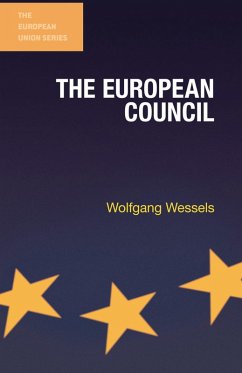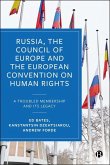- Broschiertes Buch
- Merkliste
- Auf die Merkliste
- Bewerten Bewerten
- Teilen
- Produkt teilen
- Produkterinnerung
- Produkterinnerung
This systematic assessment of the -often opaque- European Council looks at its characteristics, leaders and output as well as its impact on EU supranational and intergovernmental dynamics. Taking account of historical and contemporary developments up to and beyond the Lisbon Treaty, it encourages in-depth understanding of this key institution.
Andere Kunden interessierten sich auch für
![Responsibility of the EU and the Member States under EU International Investment Protection Agreements Responsibility of the EU and the Member States under EU International Investment Protection Agreements]() Philipp Theodor StegmannResponsibility of the EU and the Member States under EU International Investment Protection Agreements106,99 €
Philipp Theodor StegmannResponsibility of the EU and the Member States under EU International Investment Protection Agreements106,99 €![Dividing Lines Between the European Union and Its Member States Dividing Lines Between the European Union and Its Member States]() Stephen C. SiebersonDividing Lines Between the European Union and Its Member States38,99 €
Stephen C. SiebersonDividing Lines Between the European Union and Its Member States38,99 €![Jahrbuch der Europäischen Integration 2023 Jahrbuch der Europäischen Integration 2023]() Jahrbuch der Europäischen Integration 202394,00 €
Jahrbuch der Europäischen Integration 202394,00 €![Narrating Europe Narrating Europe]() Narrating Europe119,00 €
Narrating Europe119,00 €![Russia, the Council of Europe and the European Convention on Human Rights Russia, the Council of Europe and the European Convention on Human Rights]() Ed BatesRussia, the Council of Europe and the European Convention on Human Rights116,99 €
Ed BatesRussia, the Council of Europe and the European Convention on Human Rights116,99 €![Trafficking in Women in the European Union Trafficking in Women in the European Union]() Birgit LocherTrafficking in Women in the European Union53,49 €
Birgit LocherTrafficking in Women in the European Union53,49 €![Deutsche Europapolitik Deutsche Europapolitik]() Deutsche Europapolitik69,00 €
Deutsche Europapolitik69,00 €-
-
-
This systematic assessment of the -often opaque- European Council looks at its characteristics, leaders and output as well as its impact on EU supranational and intergovernmental dynamics. Taking account of historical and contemporary developments up to and beyond the Lisbon Treaty, it encourages in-depth understanding of this key institution.
Produktdetails
- Produktdetails
- The European Union Series
- Verlag: Macmillan Education
- Seitenzahl: 316
- Erscheinungstermin: 30. September 2015
- Englisch
- Abmessung: 216mm x 140mm x 17mm
- Gewicht: 395g
- ISBN-13: 9780333587478
- ISBN-10: 0333587472
- Artikelnr.: 42850715
- Herstellerkennzeichnung
- Libri GmbH
- Europaallee 1
- 36244 Bad Hersfeld
- gpsr@libri.de
- The European Union Series
- Verlag: Macmillan Education
- Seitenzahl: 316
- Erscheinungstermin: 30. September 2015
- Englisch
- Abmessung: 216mm x 140mm x 17mm
- Gewicht: 395g
- ISBN-13: 9780333587478
- ISBN-10: 0333587472
- Artikelnr.: 42850715
- Herstellerkennzeichnung
- Libri GmbH
- Europaallee 1
- 36244 Bad Hersfeld
- gpsr@libri.de
Wolfgang Wessels
PART I: THE EUROPEAN COUNCIL: OVERVIEW AND HISTORY.- 1. Introduction: The Many Faces of the European Council.- 2. Multiple Approaches for Understanding a Contested Institution: Three Models.- 3. Pre-History: the Birth of Institutionalised Summitry.- 4. History: Generations of Leaders and the Institutional Trajectory.- PART II: THE ROLE OF THE EUROPEAN COUNCIL WITHIN THE EU ARCHITECTURE.- 5. Political and Procedural Leadership: General Functions and Specific Powers.- 6. Towards a New Institutional Balance? Trends in Inter-Institutional Relations.- PART III: INSIDE THE EUROPEAN COUNCIL: THE DYNAMICS OF DECISION MAKING.- 7. The Presidency: Charismatic Master or Facilitating Manager?.- 8. Rules for Organisation: the Search for an Optimal Institutional Arrangement.- 9. Decision-Making: The Ways to Consensus Formation.- 10. Decision-Making: The Power Dimension.- PART IV: ACTIVITIES, AGREEMENTS AND ACTS.- 11. Deepening: The Constitutional Architect.- 12. Widening: The Master of Enlargement.- 13. Economic Governance: Towards a 'gouvernement économique'?.- 14. External Action: In Search of a Coherent and Effective Global Role.- 15. The Area of Freedom, Security and Justice: Pre-Constitutional and Pre-Legislative Functions.- PART V: CONCLUSIONS AND PERSPECTIVES: A KEY INSTITUTION'S RISE AND DECLINE?.- 16. The European Council: Looking Back to Look Forward.
PART I: THE EUROPEAN COUNCIL: OVERVIEW AND HISTORY
1. Introduction: The Many Faces of the European Council
2. Multiple Approaches for Understanding a Contested Institution: Three
Models
3. Pre-History: the Birth of Institutionalised Summitry
4. History: Generations of Leaders and the Institutional Trajectory
PART II: THE ROLE OF THE EUROPEAN COUNCIL WITHIN THE EU ARCHITECTURE
5. Political and Procedural Leadership: General Functions and Specific
Powers
6. Towards a New Institutional Balance? Trends in Inter-Institutional
Relations
PART III: INSIDE THE EUROPEAN COUNCIL: THE DYNAMICS OF DECISION MAKING
7. The Presidency: Charismatic Master or Facilitating Manager?
8. Rules for Organisation: the Search for an Optimal Institutional
Arrangement
9. Decision-Making: The Ways to Consensus Formation
10. Decision-Making: The Power Dimension
PART IV: ACTIVITIES, AGREEMENTS AND ACTS
11. Deepening: The Constitutional Architect
12. Widening: The Master of Enlargement
13. Economic Governance: Towards a 'gouvernement économique'?
14. External Action: In Search of a Coherent and Effective Global Role
15. The Area of Freedom, Security and Justice: Pre-Constitutional and
Pre-Legislative Functions
PART V: CONCLUSIONS AND PERSPECTIVES: A KEY INSTITUTION'S RISE AND DECLINE?
16. The European Council: Looking Back to Look Forward.
1. Introduction: The Many Faces of the European Council
2. Multiple Approaches for Understanding a Contested Institution: Three
Models
3. Pre-History: the Birth of Institutionalised Summitry
4. History: Generations of Leaders and the Institutional Trajectory
PART II: THE ROLE OF THE EUROPEAN COUNCIL WITHIN THE EU ARCHITECTURE
5. Political and Procedural Leadership: General Functions and Specific
Powers
6. Towards a New Institutional Balance? Trends in Inter-Institutional
Relations
PART III: INSIDE THE EUROPEAN COUNCIL: THE DYNAMICS OF DECISION MAKING
7. The Presidency: Charismatic Master or Facilitating Manager?
8. Rules for Organisation: the Search for an Optimal Institutional
Arrangement
9. Decision-Making: The Ways to Consensus Formation
10. Decision-Making: The Power Dimension
PART IV: ACTIVITIES, AGREEMENTS AND ACTS
11. Deepening: The Constitutional Architect
12. Widening: The Master of Enlargement
13. Economic Governance: Towards a 'gouvernement économique'?
14. External Action: In Search of a Coherent and Effective Global Role
15. The Area of Freedom, Security and Justice: Pre-Constitutional and
Pre-Legislative Functions
PART V: CONCLUSIONS AND PERSPECTIVES: A KEY INSTITUTION'S RISE AND DECLINE?
16. The European Council: Looking Back to Look Forward.
PART I: THE EUROPEAN COUNCIL: OVERVIEW AND HISTORY.- 1. Introduction: The Many Faces of the European Council.- 2. Multiple Approaches for Understanding a Contested Institution: Three Models.- 3. Pre-History: the Birth of Institutionalised Summitry.- 4. History: Generations of Leaders and the Institutional Trajectory.- PART II: THE ROLE OF THE EUROPEAN COUNCIL WITHIN THE EU ARCHITECTURE.- 5. Political and Procedural Leadership: General Functions and Specific Powers.- 6. Towards a New Institutional Balance? Trends in Inter-Institutional Relations.- PART III: INSIDE THE EUROPEAN COUNCIL: THE DYNAMICS OF DECISION MAKING.- 7. The Presidency: Charismatic Master or Facilitating Manager?.- 8. Rules for Organisation: the Search for an Optimal Institutional Arrangement.- 9. Decision-Making: The Ways to Consensus Formation.- 10. Decision-Making: The Power Dimension.- PART IV: ACTIVITIES, AGREEMENTS AND ACTS.- 11. Deepening: The Constitutional Architect.- 12. Widening: The Master of Enlargement.- 13. Economic Governance: Towards a 'gouvernement économique'?.- 14. External Action: In Search of a Coherent and Effective Global Role.- 15. The Area of Freedom, Security and Justice: Pre-Constitutional and Pre-Legislative Functions.- PART V: CONCLUSIONS AND PERSPECTIVES: A KEY INSTITUTION'S RISE AND DECLINE?.- 16. The European Council: Looking Back to Look Forward.
PART I: THE EUROPEAN COUNCIL: OVERVIEW AND HISTORY
1. Introduction: The Many Faces of the European Council
2. Multiple Approaches for Understanding a Contested Institution: Three
Models
3. Pre-History: the Birth of Institutionalised Summitry
4. History: Generations of Leaders and the Institutional Trajectory
PART II: THE ROLE OF THE EUROPEAN COUNCIL WITHIN THE EU ARCHITECTURE
5. Political and Procedural Leadership: General Functions and Specific
Powers
6. Towards a New Institutional Balance? Trends in Inter-Institutional
Relations
PART III: INSIDE THE EUROPEAN COUNCIL: THE DYNAMICS OF DECISION MAKING
7. The Presidency: Charismatic Master or Facilitating Manager?
8. Rules for Organisation: the Search for an Optimal Institutional
Arrangement
9. Decision-Making: The Ways to Consensus Formation
10. Decision-Making: The Power Dimension
PART IV: ACTIVITIES, AGREEMENTS AND ACTS
11. Deepening: The Constitutional Architect
12. Widening: The Master of Enlargement
13. Economic Governance: Towards a 'gouvernement économique'?
14. External Action: In Search of a Coherent and Effective Global Role
15. The Area of Freedom, Security and Justice: Pre-Constitutional and
Pre-Legislative Functions
PART V: CONCLUSIONS AND PERSPECTIVES: A KEY INSTITUTION'S RISE AND DECLINE?
16. The European Council: Looking Back to Look Forward.
1. Introduction: The Many Faces of the European Council
2. Multiple Approaches for Understanding a Contested Institution: Three
Models
3. Pre-History: the Birth of Institutionalised Summitry
4. History: Generations of Leaders and the Institutional Trajectory
PART II: THE ROLE OF THE EUROPEAN COUNCIL WITHIN THE EU ARCHITECTURE
5. Political and Procedural Leadership: General Functions and Specific
Powers
6. Towards a New Institutional Balance? Trends in Inter-Institutional
Relations
PART III: INSIDE THE EUROPEAN COUNCIL: THE DYNAMICS OF DECISION MAKING
7. The Presidency: Charismatic Master or Facilitating Manager?
8. Rules for Organisation: the Search for an Optimal Institutional
Arrangement
9. Decision-Making: The Ways to Consensus Formation
10. Decision-Making: The Power Dimension
PART IV: ACTIVITIES, AGREEMENTS AND ACTS
11. Deepening: The Constitutional Architect
12. Widening: The Master of Enlargement
13. Economic Governance: Towards a 'gouvernement économique'?
14. External Action: In Search of a Coherent and Effective Global Role
15. The Area of Freedom, Security and Justice: Pre-Constitutional and
Pre-Legislative Functions
PART V: CONCLUSIONS AND PERSPECTIVES: A KEY INSTITUTION'S RISE AND DECLINE?
16. The European Council: Looking Back to Look Forward.








